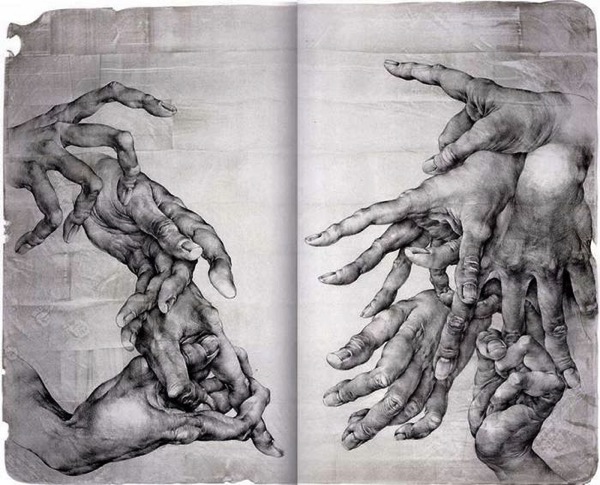
Günther Anders’ philosophy of technology (as developed most fully in his two-volume monograph Die Antiquiertheit des Menschen [The Obsolescence of the Human] [1956, 1980]) has yet to be translated in full, but it’s nevertheless a productive exercise to read its title against Anders’ own intentions – that is to say, the obsolescence of the human as a possibility or a promise rather than as something to be forestalled or mourned. In part, this is because we’re already quite familiar with his argument, so it serves as a useful foil. For Anders neatly encapsulates many current anxieties about the status of the human faced with the inhumanist dynamics of modern technics. In this regard, Anders is a prime representative of the very influential German critique of technology (see also Martin Heidegger, Arnold Gehlen, and Hans Jonas). Throughout his work, Anders makes three central claims: (1) the technical artifacts we make can now outstrip us functionally – that is to say, they can do what we can do, only “harder better faster”; (2) the technical artifacts we make are made faster than we can (collectively or individually) accommodate, comprehend, model, or take responsibility for them; and (3) we find ourselves compelled by the imperative to make or do whatever we are able to make or do, regardless of consequences and considerations. Ultimately, this leads Anders to lament what he intimates is a new human condition, characterized by what he calls “Promethean shame,” or the experience of shame at the fact that we (humans) are born and not made (i.e., machined or produced in the manner of technical artifacts). For Anders, this new condition is inane and self-destructive. Even worse, it proceeds on the basis of a fundamentally erroneous apprehension of what it actually means to be human. On Anders’ view, to be human is to have your conditions given to you (by the accident of birth) rather than to make or remake them (as the so-called Prometheans desire or envy).
Against Anders, consider the icy black inhumanist rationalism of Ray Brassier, articulated rather cuttingly in his “Prometheanism and Its Critics” (2014). Brassier argues that critical or negative portraits of “Prometheus” (for a quite orthogonal reading of this figure, see Bernard Stiegler’s vertiginous reconstruction: 1, 2, 3) rely upon hidden and undesirable assumptions. For Brassier, philosophers like Anders (and Heidegger and Hannah Arendt and all the other philosophers of finitude) “presuppose that there is a neutral, which is to say, transcendently ordained equilibrium” inherent to the world at an ontological level. In other words, the following idea is simply assumed by such philosophers (and then weaponized, insofar as it is used to shut down inquiries and revisionary programs): that humans, in fact, have their conditions given to them (by Being, or existence, or God, or nature, or whatever, or whoever), such that introducing disequilibria (i.e., modifications or strong redescriptions) is arrogance and foolishness incarnate. For them, the very idea of repurposing ourselves, much less the world, is dangerous, indefensible, inhuman. Brassier writes:
But the world was not made: it is simply there, uncreated, without reason or purpose. And it is precisely this realization that invites us not to simply accept the world as we find it. Prometheanism is the attempt to participate in the creation of the world without having to defer to a divine blueprint. It follows from the realization that the disequilibrium we introduce into the world through our desire to know is no more or no less objectionable than the disequilibrium that is already there in the world.
Principally at issue between Anders and Brassier is whether or not and to what extent our negotiations with objects (and, consequently, our navigation of object worlds) cashes out into a program of prescribed nonintervention or else warrants the program of strong redescription and repurposing I propose. This leads us to ask: Can we be pragmatists about everything – about ourselves, about whole worlds? In part, I’d like to suggest that we’ve already been issuing forth the kinds of revisions that critics like Anders lament. This isn’t because of some specific historical or technological turning point. Nor is it because humans are radically or uniquely “open” or underprogrammed in the way that quasi-existentialists like Heidegger and Arendt (or even poststructuralist figures like Jacques Derrida) suggest. To the contrary, it’s only insofar as we’re able to access or exercise rationality (and rationality is something you do, not something you have) that, as Paul Feyerabend famously claims, “Anything goes.” But this is the fundamental insight underlying the operation of reason itself, because reason is a contingent, error-tolerant, and interminable process according to which any prior belief or statement undergoes tests that machinically produce its own revision. If reason matters, then we don’t have to commit to some immaterial voluntarism, but we also don’t have to cite whichever mythologies of givenness in order to secure our tools and workspace. In other words, “to understand the commitment to humanity and to make such a commitment, it is imperative to assume a constructive and revisionary stance with regard to the human.”
Call my stance a form of wild pragmatism. The purpose of a wild pragmatism isn’t to propose tentative solutions that we consequently reject or shelve when they fail to immediately transform the world. Instead, its purpose is to serve as a speculative engine that can’t stop generating affects, concepts, hypotheses, programs, questions, and regimes of description and redescription, all intended to emphasize and reprogram the exigencies at hand. This is precisely why, from the start, the sinister pathway of the object figures so prominently in my account. It avoids parsing the world out into passive objects on the one hand and active subjects on the other. Taking the object seriously in this fashion helps to avoid getting stranded in the desert of ontological exceptionalism (any ontology that starts off by asserting that “The human being is absolutely and constitutively different than everything else in the universe” is desertic). But note that meaningful ontological distinctions are nevertheless preserved, indeed, vivified – that is to say, distinctions between different objects and kinds of objects and object worlds. The flat ontology I describe doesn’t eliminate verticality. Mountains and valleys are part of the landscape, not radical breaks from it.
Practically speaking, perhaps the most important distinction of all is the distinction between the sinister pathway of the object and the workspace of the subject. Workspace here refers to the domain of possible activity (constrained in all sorts of ways, yes, but open to expansion and revision) that each subject occupies. Think of the workspace almost as a peculiar type of prospectus attending the peculiar type of object we (for now) call a subject. Objects pass through the workspace all the time, and it’s in the workspace that object use takes place. This opens up a new model for conceptualizing object use. Instead of mere dexterity, for which passive objects get manipulated by a more or less dexterous subject (what Winnicott calls object relation), the workspace model allows for the agency and autonomy of the object as a precondition for its use. It even leverages that agency and autonomy in order to make repurposing the object more feasible and flexible.
In closing, consider chirality: the property that describes non-superimposable mirror images. In mathematics, chiral knots refer to knots (i.e., to circles embedded in three-dimensional Euclidean spaces, or in 3-spheres, which are higher-dimensional analogues of spheres) that are not equivalent to their mirror images. A relatively simple real-world example of a chiral knot is the trefoil. Chirality also informs biological and chemical structures (like the bilateral animal morphology, or enantiomers, which are chemically identical molecules that nevertheless evidence chiral differences in atomic placement, leading to surprisingly varied interaction effects), as well as gene expression. Another way of thinking about chirality is that it is the constitutively structural asymmetry inherent to the handedness of the world. Handedness – this is not to imply that the world was made by hand, much less that it was made for human hands. Chirality, or handedness, is a way of characterizing productive asymmetries. Think of chirality as a conceptual scheme or a toolset that can be leveraged; the only way to follow a sinister pathway is by crabwalking in thought. Coordinate the right hand with the left in order to repurpose the world. Recall an old dictum from the early days of structuralist anthropology: “The right hand stands for me, the left for not-me, others.” Or, as an old book says, sheep on the right, goats on the left.
Go back to to Part 4 (“An informal algorithm for repurposing worlds”) or see “The left hand of all creation: how to repurpose whole worlds.”
